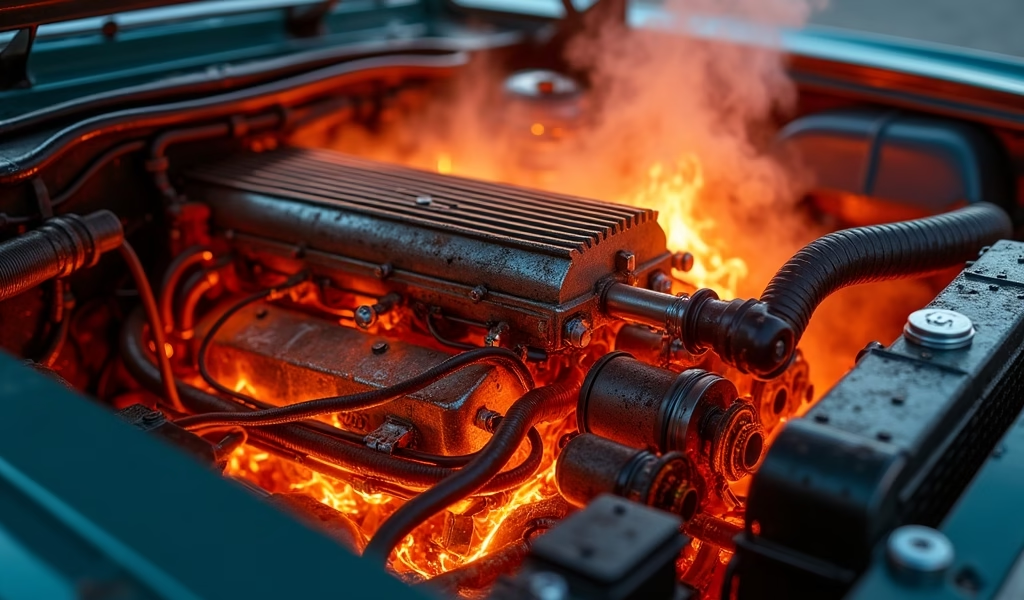Overview
The article explains temperature rating classifications in automotive systems and provides five essential tips for vehicle owners: understanding your vehicle’s operating temperature range, selecting appropriate fluids based on temperature ratings, recognizing component-specific temperature needs, monitoring thermal conditions, and adapting to seasonal changes. Proper attention to temperature ratings helps extend vehicle lifespan, improve reliability, and prevent costly repairs across various driving conditions and environments.
Table of Contents
- Understanding Temperature Rating Classification
- Importance of Temperature Ratings in Automotive Systems
- Five Essential Tips for Temperature Rating Classification
- Tip 1: Know Your Vehicle’s Operating Temperature Range
- Tip 2: Choose the Right Fluids Based on Temperature Ratings
- Tip 3: Understand Component-Specific Temperature Classifications
- Tip 4: Monitor and Maintain Optimal Temperature Conditions
- Tip 5: Adapt to Seasonal and Environmental Changes
- Real-World Applications of Temperature Rating Knowledge
- Conclusion
- Frequently Asked Questions
Understanding Temperature Rating Classification
Temperature rating classification is a critical aspect of automotive engineering that often goes unnoticed by everyday drivers. As a mechanic with over 15 years in the field, I’ve seen firsthand how understanding these ratings can make the difference between a vehicle that performs reliably for years and one that faces constant issues. Temperature ratings indicate the range within which components and fluids can safely operate, making them essential knowledge for proper vehicle maintenance.
When we talk about temperature rating classification in vehicles, we’re referring to the standardized system that categorizes components, fluids, and materials based on their ability to function within specific temperature ranges. These classifications aren’t just arbitrary numbers—they’re carefully determined through extensive testing and reflect real-world performance parameters that directly affect your vehicle’s reliability and longevity.
Think of temperature ratings as your car’s comfort zone. Just like you might feel great at 70°F but struggle in extreme heat or cold, your vehicle’s components each have their ideal operating temperatures. Stepping outside these boundaries doesn’t just cause discomfort—it can lead to accelerated wear, reduced efficiency, and even catastrophic failure in severe cases.
Importance of Temperature Ratings in Automotive Systems
The significance of temperature rating classifications extends throughout your entire vehicle. From your engine oil to your brake fluid’s boiling point temperature, these ratings ensure that each component functions optimally under various conditions. When components operate within their designated temperature ranges, you’ll experience better fuel efficiency, extended component life, and reduced chances of unexpected breakdowns.
Modern vehicles face increasingly demanding temperature challenges. With smaller engine compartments packed with more technology, heat management has become more critical than ever. Simultaneously, consumers expect vehicles to perform flawlessly from the frigid Arctic to scorching deserts. This is where temperature rating classifications become invaluable—they provide manufacturers, mechanics, and vehicle owners with clear guidelines for selecting appropriate materials and fluids.
Understanding temperature ratings also helps in diagnosing problems before they become serious. For instance, if a component consistently operates near the upper limit of its temperature rating, it might indicate an underlying issue with cooling systems or excessive friction. By monitoring these parameters, we can often catch problems early, saving both money and headaches down the road.

Five Essential Tips for Temperature Rating Classification
Now that we understand the importance of temperature ratings, let’s dive into five practical tips that will help you apply this knowledge to keep your vehicle running at its best. These tips aren’t just theoretical—they’re based on real-world experience working with thousands of vehicles across diverse operating conditions.
Each of these tips focuses on a different aspect of temperature rating classifications, from understanding your specific vehicle’s needs to selecting appropriate fluids and components. By implementing these recommendations, you’ll be taking proactive steps toward extending your vehicle’s lifespan and improving its reliability in various weather conditions.
Tip 1: Know Your Vehicle’s Operating Temperature Range
The foundation of proper temperature management starts with understanding your specific vehicle’s normal operating temperature range. While most modern engines are designed to operate at approximately 195-220°F (90-105°C), this can vary based on make, model, and engine design. Your owner’s manual is the first place to look for this information, but you can also consult with a qualified mechanic or the manufacturer directly.
Pay particular attention to your vehicle’s thermostat opening temperature, as this is a critical component in regulating engine heat. The thermostat typically opens between 180-195°F (82-90°C), allowing coolant to flow through the radiator and maintaining optimal engine temperature. If your thermostat opens too early or too late, it can affect fuel efficiency and engine performance.
Modern vehicles have sophisticated temperature monitoring systems that provide real-time data on various components. Familiarize yourself with your dashboard indicators, particularly the coolant temperature warning light, which illuminates when the engine is operating outside its normal temperature range. Understanding these indicators can help you identify potential issues before they lead to serious damage.
Tip 2: Choose the Right Fluids Based on Temperature Ratings
Automotive fluids have some of the most critical temperature rating classifications in your vehicle. Engine oil, for instance, is rated using viscosity grades (like 5W-30) that indicate how it flows at both cold starting temperatures (the “W” number) and at normal operating temperatures (the second number). Lower W numbers provide better cold-weather protection, while higher second numbers offer better protection in hot conditions.
Coolant (antifreeze) selection should be based on your climate and vehicle specifications. Modern coolants are typically rated to protect against freezing down to -34°F (-36°C) and boiling up to 265°F (129°C) when used in a properly pressurized cooling system. In extreme climates, you might need specialized formulations with expanded temperature ranges or different glycol concentrations.
Transmission fluid, power steering fluid, and brake fluid all have their own temperature classifications as well. For example, DOT 3 brake fluid has a dry boiling point of at least 401°F (205°C), while higher-performance DOT 4 fluid must withstand at least 446°F (230°C). Using fluids with appropriate temperature ratings for your driving conditions is essential for system longevity and safety.
Tip 3: Understand Component-Specific Temperature Classifications
Beyond fluids, individual components in your vehicle have their own temperature rating classifications. Belts and hoses, for instance, are typically rated for continuous operation between -40°F to 257°F (-40°C to 125°C), but these can vary by manufacturer and material composition. Premium silicone hoses often offer expanded temperature ranges compared to standard rubber versions.
Electrical components like sensors, modules, and batteries have specific temperature tolerances that affect their performance and lifespan. For example, most automotive batteries perform optimally between 32°F and 80°F (0°C and 27°C). Outside this range, battery capacity can decrease significantly—up to 60% at 0°F (-18°C) according to research from the National Renewable Energy Laboratory.
When replacing components, don’t automatically opt for the cheapest option. Instead, consider temperature rating classifications based on your typical driving conditions. If you live in an area with extreme temperatures or use your vehicle for demanding applications like towing or performance driving, investing in components with expanded temperature ratings can provide significant long-term benefits and reduce maintenance costs.

Tip 4: Monitor and Maintain Optimal Temperature Conditions
Proactive monitoring is key to ensuring your vehicle’s components operate within their temperature rating classifications. Modern OBD-II scanners can provide real-time temperature data for various systems, giving you insights beyond what dashboard gauges show. For around $30-100, these tools can help you track engine coolant temperature, intake air temperature, transmission fluid temperature, and more.
Regular maintenance significantly impacts your vehicle’s ability to maintain proper operating temperatures. A cooling system flush every 30,000-50,000 miles ensures efficient heat transfer and prevents corrosion. Similarly, changing oil according to manufacturer specifications—not just mileage but also time intervals—ensures proper lubrication and heat dissipation.
Don’t overlook the importance of airflow in temperature management. Keep radiator fins clean and free of debris, ensure electric cooling fans operate properly, and maintain adequate clearance around heat-generating components. Even simple actions like parking in shade on hot days or using an engine block heater in extreme cold can help keep components within their optimal temperature ranges.
Tip 5: Adapt to Seasonal and Environmental Changes
Temperature rating classifications become especially important during seasonal transitions. As temperatures shift from summer to winter or vice versa, consider adjusting your maintenance strategy. In colder months, using lower-viscosity oils (when approved by your manufacturer) can improve cold-start protection and reduce initial wear. Conversely, summer driving—especially in hot climates—may benefit from slightly higher-viscosity oils to maintain proper protection.
Environmental factors beyond ambient temperature can affect your vehicle’s thermal management. High-altitude driving, for instance, typically results in cooler operating temperatures due to lower air density, which might require adjustments to cooling systems. Heavy traffic and stop-and-go driving generate more heat and require more robust cooling capacity compared to highway cruising.
If you’re planning a significant change in driving conditions—like relocating to a different climate or using your vehicle for towing—consult with a professional mechanic about potential modifications. Simple adjustments like installing a transmission cooler or upgrading to a high-capacity radiator can significantly extend component life by keeping temperatures within optimal ranges despite changing demands.
Real-World Applications of Temperature Rating Knowledge
Understanding temperature rating classifications pays dividends in real-world situations. Consider this example: a customer brought in a vehicle that consistently overheated during summer months despite having a seemingly functional cooling system. By investigating temperature ratings of the installed components, we discovered that the previous owner had installed an aftermarket thermostat with an opening temperature 15°F higher than the manufacturer’s specification, creating a cascading effect of heat-related issues.
Another practical application involves selecting the right engine oil. A delivery driver operating in Minnesota experiences temperature swings from -30°F in winter to 95°F in summer. By understanding viscosity ratings and switching between a 0W-20 oil in winter and a 5W-30 in summer (both within manufacturer specifications), they were able to optimize engine protection and starting reliability across all seasons.
Temperature rating classifications also apply to modifications and upgrades. When installing performance parts like turbochargers or high-output electrical systems, heat generation increases substantially. Successful upgrades require careful consideration of temperature ratings for all affected components, from exhaust manifold gaskets to wiring harnesses. Overlooking these ratings often leads to premature failures and expensive repairs.
Conclusion
Temperature rating classification might seem like a technical detail best left to engineers, but as we’ve explored throughout this article, understanding these ratings has practical implications for every vehicle owner. By knowing your vehicle’s normal operating ranges, selecting appropriate fluids and components, monitoring conditions, and adapting to environmental changes, you can significantly extend your vehicle’s lifespan and improve its reliability.
These five tips provide a foundation for applying temperature rating knowledge to your maintenance routine. Remember that vehicles are complex systems where temperature affects virtually every component. Taking the time to understand these classifications isn’t just about preventing problems—it’s about optimizing performance, efficiency, and longevity.
Next time you’re selecting engine oil, replacing a component, or troubleshooting an issue, consider the temperature rating classifications involved. This knowledge empowers you to make informed decisions that will keep your vehicle running at its best through all seasons and conditions. Your vehicle will thank you with years of reliable service, and you’ll enjoy the peace of mind that comes from knowing you’re taking care of one of your most significant investments.
Frequently Asked Questions
What does the “W” in oil viscosity ratings like 5W-30 mean?
The “W” stands for “Winter” and indicates the oil’s flow characteristics at cold temperatures. Lower W numbers (like 0W or 5W) provide better cold-start protection in winter conditions.
How often should I check my vehicle’s operating temperature?
Monitor your temperature gauge regularly during each drive, especially during extreme weather conditions. A quick glance at your temperature gauge during each drive can help catch abnormal trends early.
Can I use fluids with higher temperature ratings than recommended?
While using fluids with higher temperature ratings is generally acceptable, they might not provide optimal performance in all conditions. Always follow manufacturer recommendations for best results.
How do temperature ratings affect electric and hybrid vehicles?
Electric and hybrid vehicles have even more critical temperature management systems than conventional vehicles. Battery performance and lifespan are highly temperature-dependent, typically operating best between 60-80°F (15-27°C).
Do aftermarket parts have the same temperature ratings as OEM parts?
Quality varies widely among aftermarket parts. Premium aftermarket components often meet or exceed OEM temperature specifications, while budget options may have reduced temperature tolerances.


Pingback: Winter Tire Compound Chemistry: 5 Tips - knowsyourcar.com